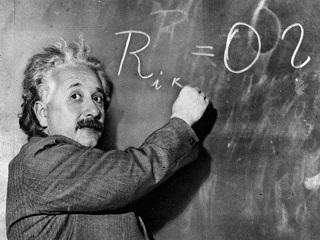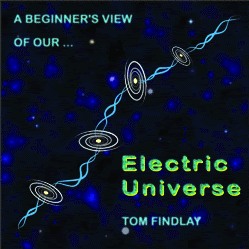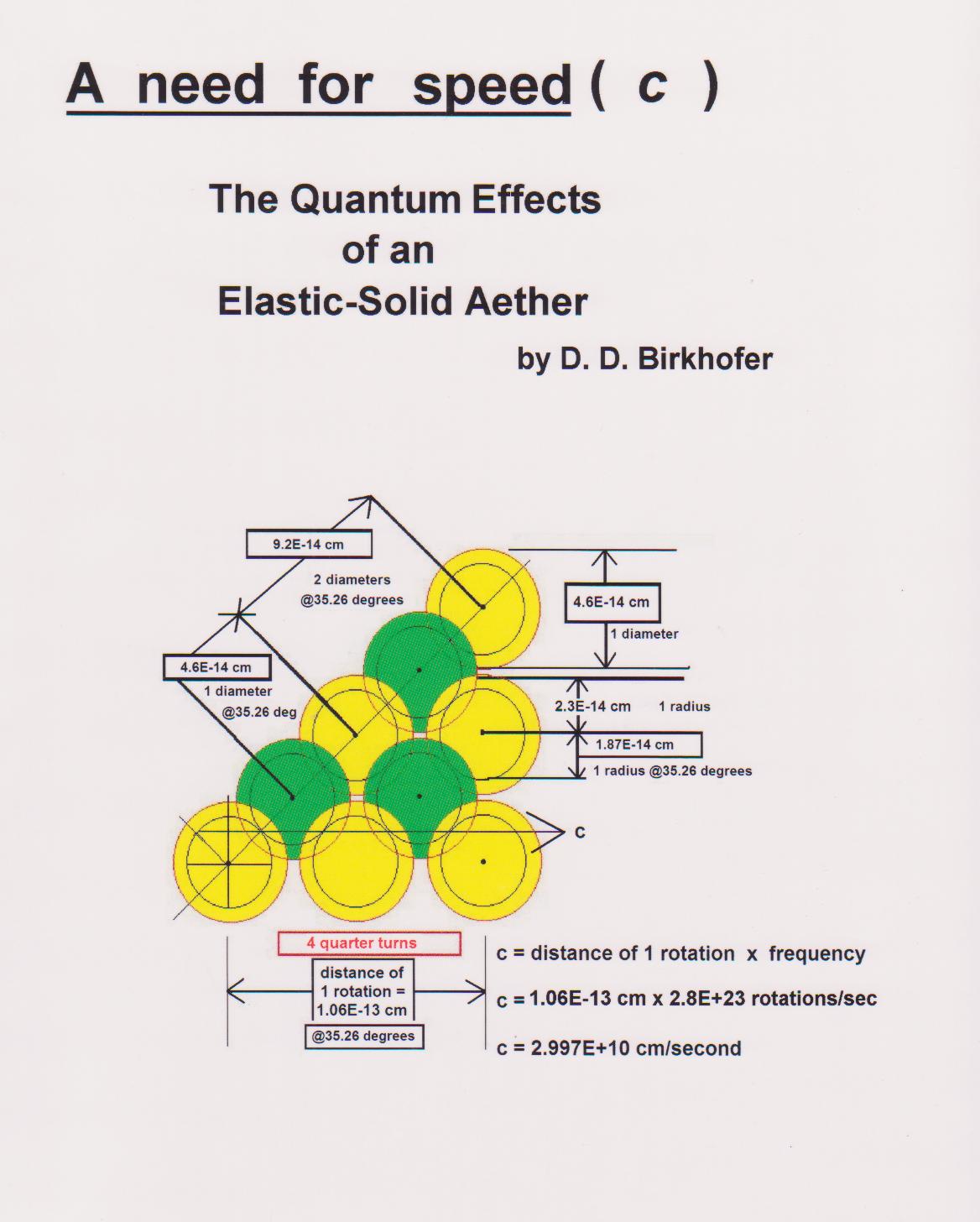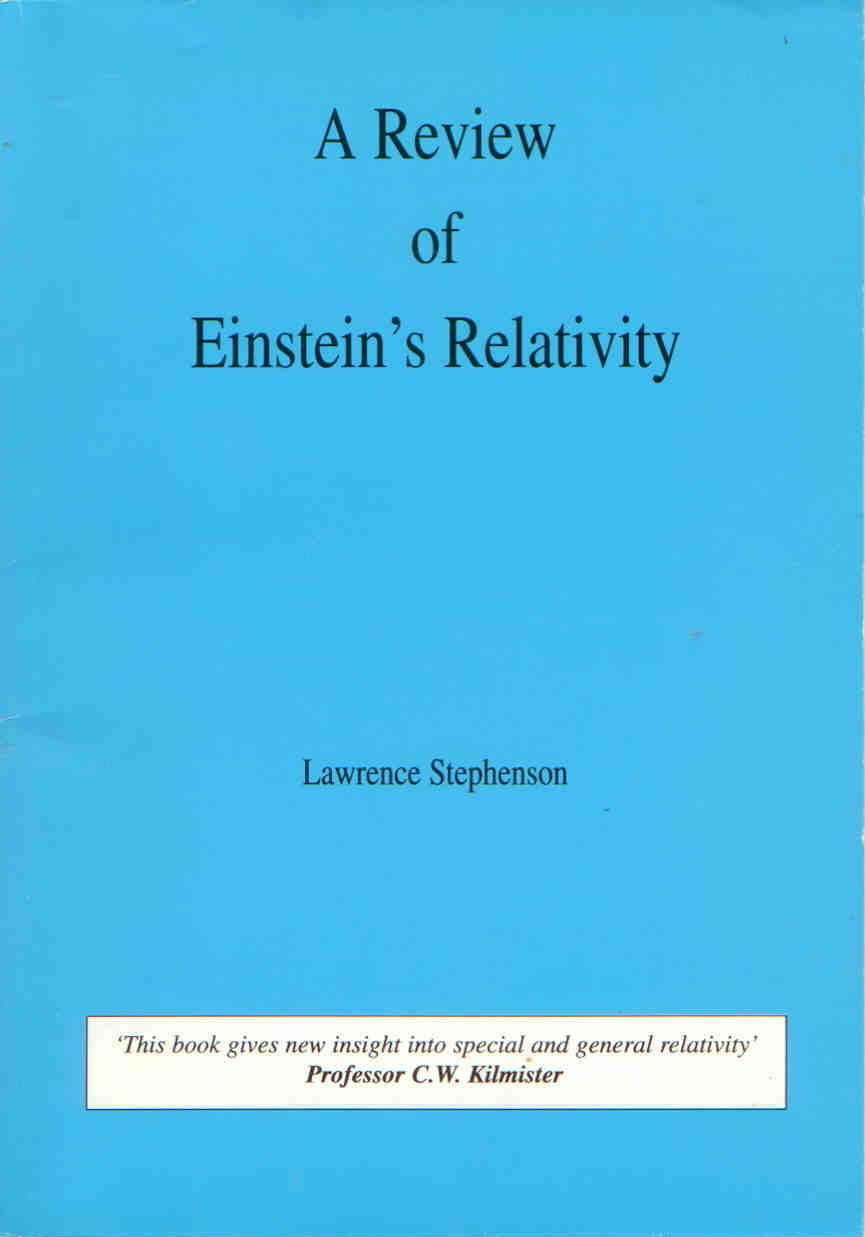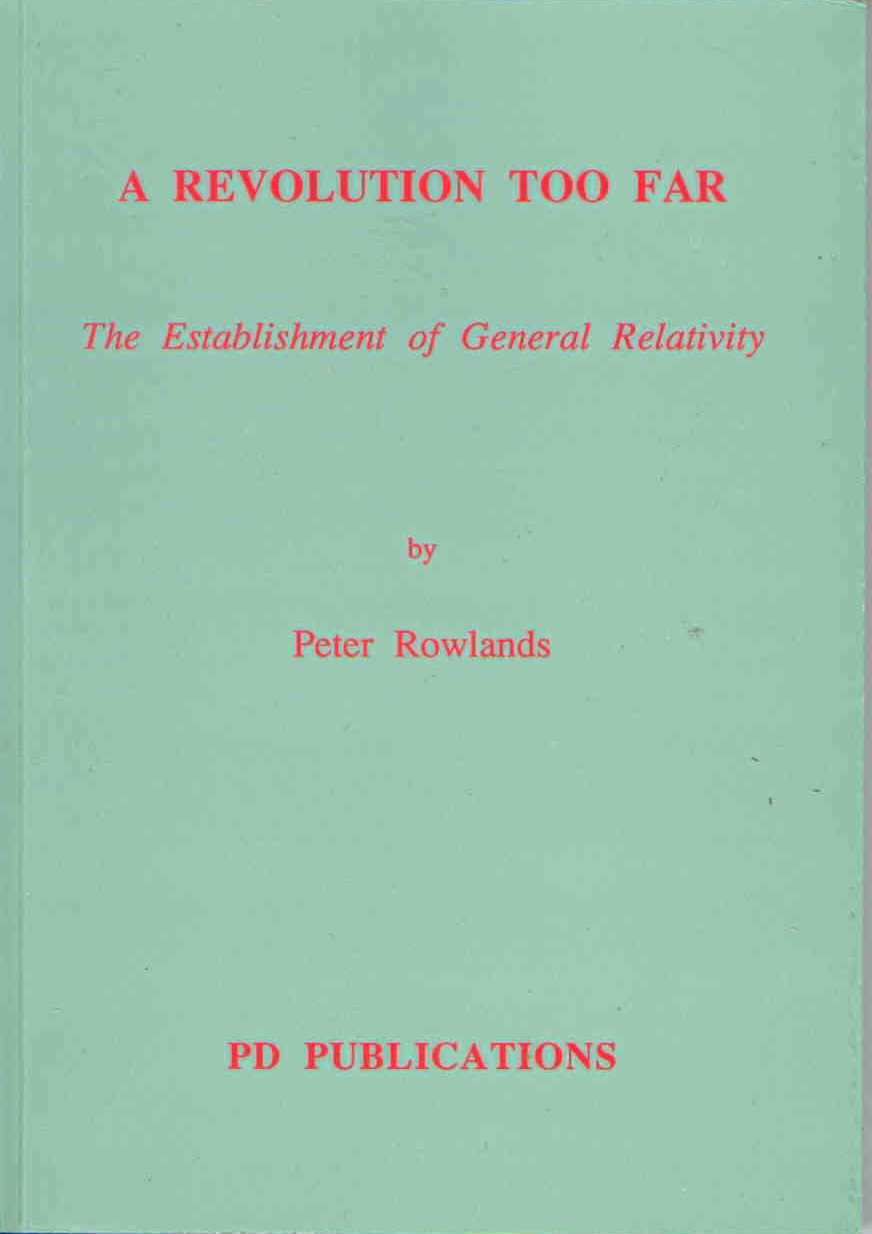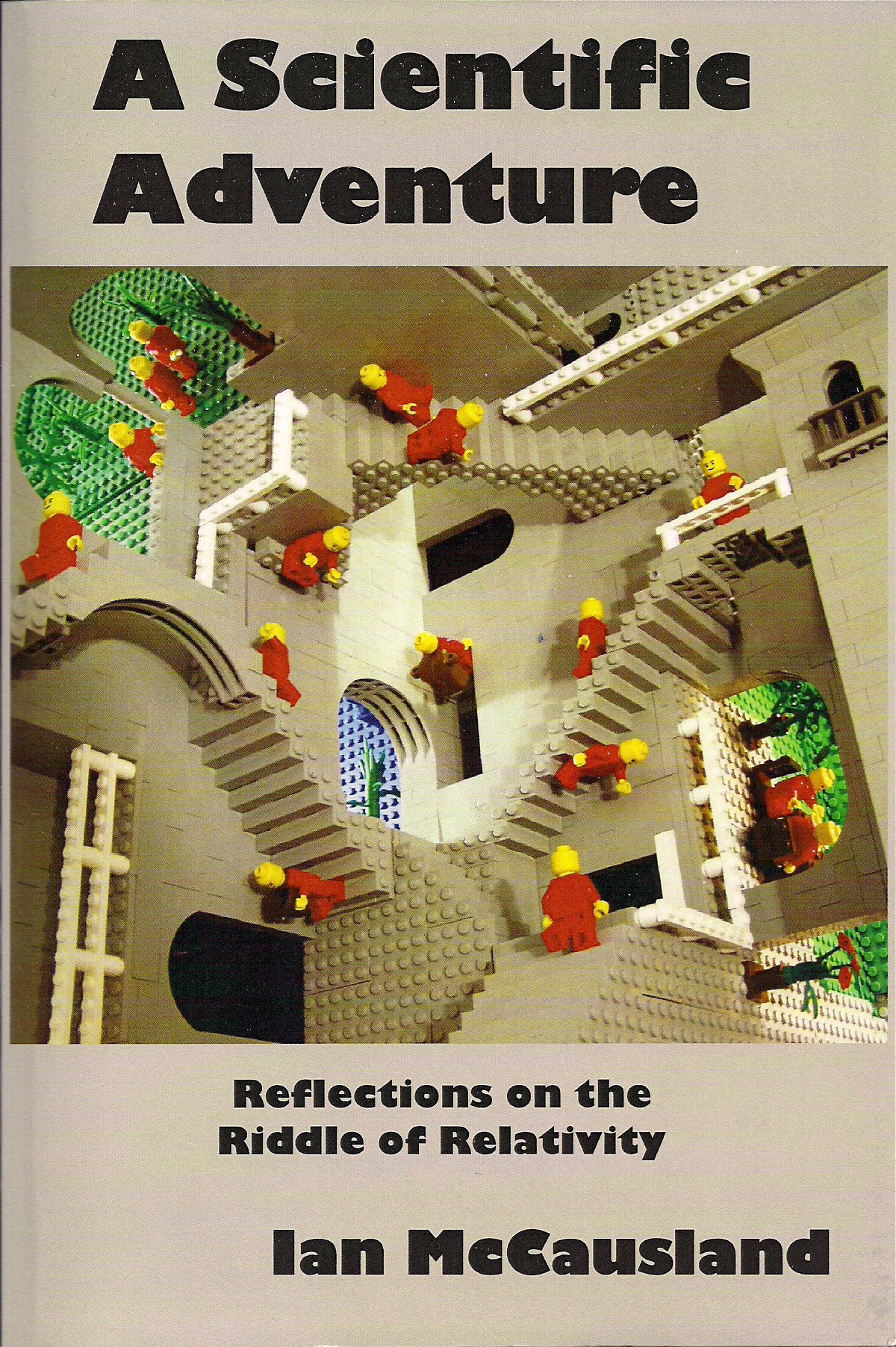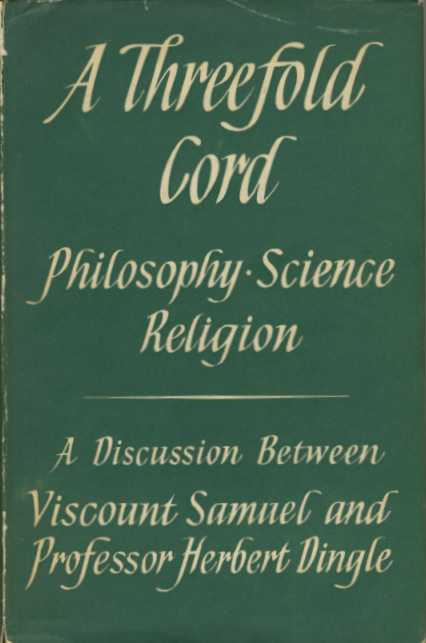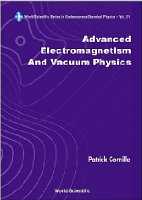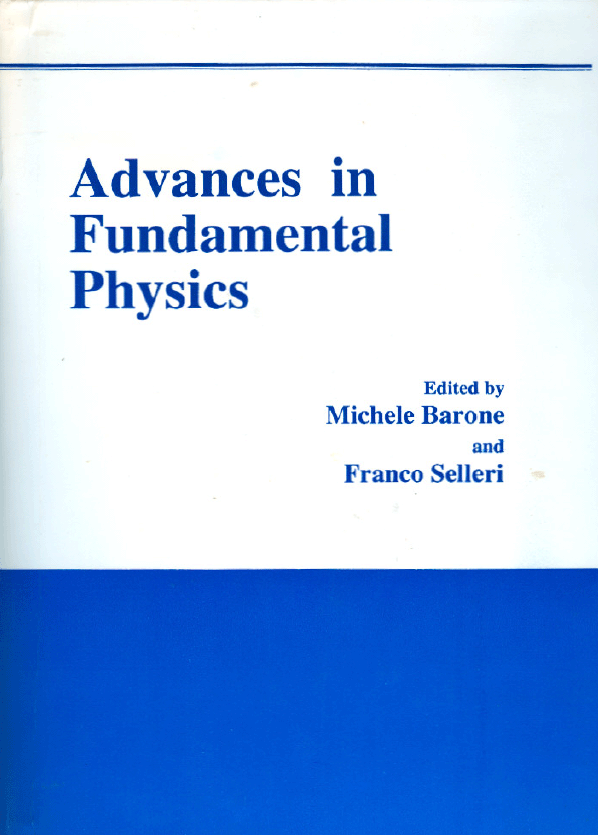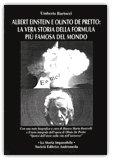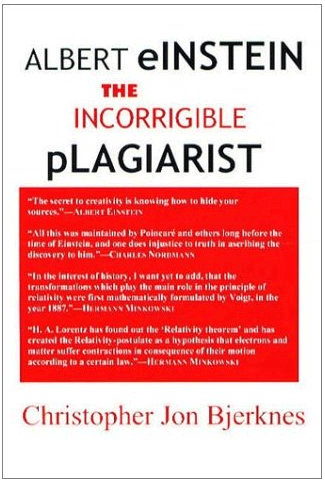(See right-hand panel for a full list of scientists, papers, and books)

View count: 1
Pages: 320
Publisher: Peter R?sch
Year: 2005
ISBN: 3000160388
In akribischer Detailarbeit ist der Autor Peter R?sch den eigenartig parallelen Gedanken des Patentamtsangestellten Einstein und einer damals ber?hmten Mathematik-Koryph?e nachgegangen. Die historischen Forschungen f?hrten R?sch zu Ergebnissen von verheerender Brisanz?

View count: 1
Pages: 51
Publisher: Ekkehard Friebe & Jocelyne Lopez
Year: 2003/2006
Websites: www.ekkehard-friebe.de www.jocelyne-lopez.de/blog www.ekkehard-friebe.de/blog
Download and read it now
This is an English translation of portions of the larger work, Ueber die absolute Groesse der speziellen Relativitaetstheorie. G. O. Mueller and Karl Kneckebrodt are pseudonyms chosen for the project.
Description of a German research project of international scope, presenting a documentation of 3789 publications criticizing the theory (1908-2003), distributing this documentation to libraries, to the printed media, and to eminent representatives of public opinion, and addressing open letters to the members of the German Federal Parliament (Bundestag), and to journals of several German newspapers.
I was so impressed by what I found described within the Electric Universe (EU) model when I first came across it that I decided to write a book about it. I made this decision not for personal gain, but instead, so that others like me could also have the chance to understand the important things that model proposes. In short, the EU model stands as a basis on which to explain how our universe actually does work. It is a set of alternative theories to those we have all been told for so long are true by mainstream astro-science and by the media.
I came across the Electric Universe model in early 2010, and as a layman, having previously studied the already available science of the universe quite deeply, I immediately wondered why I had never seen or heard anything about these alternative theories before. Also, as I delved into the EU model's historical background and current status, I began to uncover associated information that was new to me and which made me realise that all is not well in the world of astro-science research, and that things have not been okay there for a very long time.
Being the way I am, and based on my past experience, my education and natural interests, what emerged was a picture that I found hard to contemplate. This picture, constructed from the credible work of many honourable, but for some apparently odd reason, relatively unknown scientists and researchers, was one which I just had to provide for others an opportunity to understand. The story this picture presents is that today's scientific research into astronomy and the physics of our universe has basically got it wrong, and that there has existed for quite some time alternative theories that appear to be far more logical and correct. In short, our universe seems not to work primarily on gravity, as we have been brainwashed to believe; instead, it seems to work on electricity, or more precisely, the electromagnetic force. The ramifications that emerge from this are very wide, very deep and very important indeed.
The book "A Beginner's View of Our Electric Universe" starts off with my discovery of the EU model then goes on without recourse to mathematics or difficult language to explain the background to that model and to highlight its superior position in relation to the current gravity-based Standard Model with its insurmountable problems. It then covers some basic theory before introducing a few of the important scientists and researchers who have been involved historically in the theories that underpin the EU model, and also some of those who remain to take it forward today. Finally, it provides easy to understand explanations for the theories upon which the EU model is built, while describing where and how these fit in terms of what we observe in space today. I then finish with a few additional thoughts of my own at the very end.
My book is not aimed at the uninterested man or woman on the street. It is aimed instead at three main areas of open-minded, technically interested people: the naturally curious who are careful how they investigate and who are uninitiated in such things as the workings of space but who want to get to know; those who through their own way of thinking have already become suspicious of the stories from mainstream astro-science and the media of how the universe works, and those who already know that the gravity-based Standard Model of the universe is not correct and who are now actively searching for better theories. By finding your way to this website you may fit into one or other of these categories, and so I invite you, with the option of no financial cost, to download my book, read it and think for yourself of what it presents.
?We should not surrender our judgement to others;
we must reclaim our ability to doubt and think for ourselves.?
Tom Findlay
View count: 1
Pages: 98
Publisher: Delta Publications (New Delhi, India)
Year: 1982
ISBN: B001OMTSWO
ISBN: B0006EEVHI
Pages: 34
Publisher: Fritz K. Preikschat
Year: 1976
ISBN: B0006CXHK2
Download and read it now
CONTENTS:
- THE THEORY OF RELATIVITY HAS NO ACCEPTABLE ANSWER 1
- A LOOK BACK IN TIME 3
- VELOCITY OF LIGHT MEASUREMENTS 5
- THE "CLASSICAL" EXPERIMENTS
- MICHELSON MORLEY 7
- MICHELSON'S MOVING MIRROR EXPERIMENT 8
- IVES AND STILWELL 16
- CONCLUSIONS FROM 1-4 17
- THE RELATIVISTIC MASS 19
- GRAVITATIONAL DOPPLER SHIFT 21
CONCLUSIONS
- THE BIG BANG 22
- A SMALL BANG 23
- NEUTRON STARS AND BLACK HOLES 28
- NUCLEAR FUSION POWER 32
Pages: 154
Publisher: Open Court Publishing Co.
Year: 1927
ISBN: B000NW6EZU
ISBN: B001U6X92Y
ISBN: B0006AK1VM
ISBN: B0016H446M
"The debate on relativity contained in this volume was held at Indiana Unversity on May 21 and 22, 1926, under the auspices of the Indiana chapter of Sigma Xi. Because of the profound influence that this new doctrine has already has upon philosophic thought and the attention it has directed to the foundations of mathematical physics, it is important that the most careful scrutiny should be given to the postulates which underlie it and to the experimental evidence upon which it rests. Recently the work of Professor Dayton C. Miller has threatened the experimental foundations of the theory and a reasonable doubt as to its validity has been entertained by a group of scientific men..." - Introduction
Professors Carmichael and Davis spoke in favor of the theory, MacMillan and Hufford against. The debate was introduced and moderated by Indiana University President William Lowe Bryan.
This Omnibus clarifies and corrects the theory in such a way that the reader comes to a superior understanding of it. The beauty of it is that one does not have to be a mathematical wizard to follow the process. The math is not only simple but each equation is explained in detail. The illustrations help a great deal also. On the whole, the Omnibus is a fascinating learning experience in which one is brought to the forefront of the discipline.
Pages: 332
Publisher: Gerald Lebau
Year: 2007
ISBN: 0615153917
ISBN: 978-0615153919
Websites: stores.lulu.com/glird
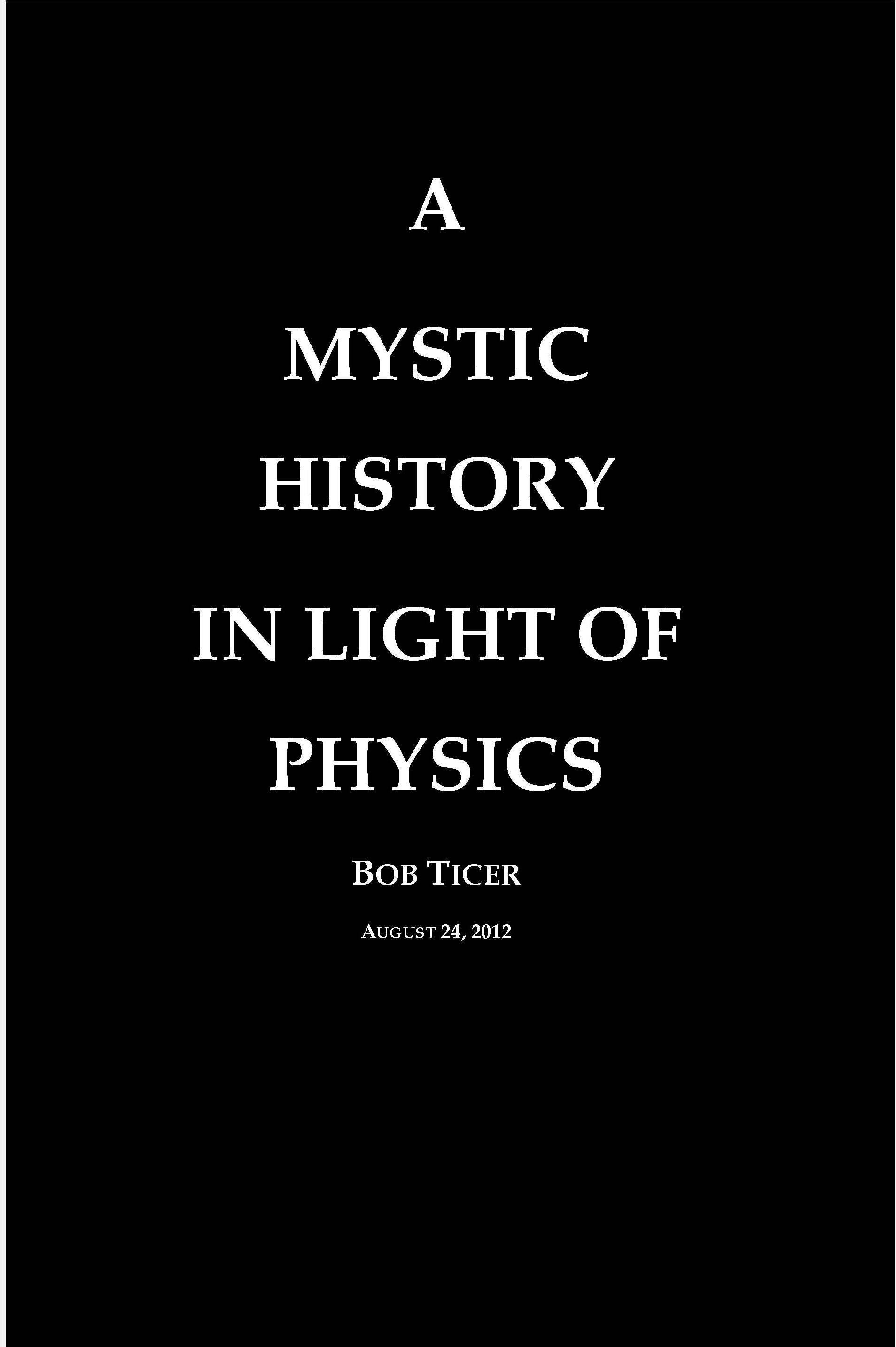
View count: 1
The math allows us to accurately describe specific aspects of nature. The math complexity also simplifies the task for experts in the field, but it is not needed for a fundamental understanding of theory.
A fundamental understanding of theory can also be undertaken in accordance with its history as a step by step progression providing a convenient reference to which everyone can relate. However, the history of physics has a mystical side to it. For instance, in view of Aristotelian physics this mystical element included light as the means from which the divine source of all creation supplied the material world with motion and energy. Nowadays relativity of space and time, and of mass and energy, is now described according to how light moves and interacts with matter. Moreover, the whole universe is now assumed to be finite whereby all of its enormous matter and energy expanded, and still expands, from a singularity, a space so tiny that it cannot be defined. Adding to this theory are concepts of dark matter, dark energy, black holes, worm holes, other dimensions, other universes and so forth.
The expanding universe cosmology struggled for a decade or more to become accepted by the majority of mainstream physicists. This difficulty of acceptance is typical of a new theory attempting to overcome the dogmatic view of the establishment. Copernicus, for instance, struggled to establish the heliocentric theory of Earth and the other planets in the solar system, as the Aristotelian doctrine of Earth at rest in the center of the universe had become the official position of the Catholic Church for its interpretation of reality.
Big bang theory of an expanding universe is now part of the establishment, but throughout history the establishment has been revolutionized by new theory for its ability to better explain new discoveries. It also is questionable whether big bang theory will remain in the distant future as established as it is now. It does have a determined challenge of an ?electric universe? theory explaining the cause of light distortion as due to its encounter with the existence of a plasmatic state of matter in intergalactic space instead of as due to an expansion between galaxies.
The electric universe and expanding universe are both theories with historical origins. Even though the expanding universe theory is now the more popular of the two, in time it could possibly be superseded by the other one. As to whether such speculation of dark energy and worm holes are retained as part of an all embracing new theory or are eventually regarded as having a mystical outlook could very well depend on a general step by step interpretation of the history of theory.
A complete understanding of all this seems out of reach for the simple minded. However, Einstein once suggested an understanding of relativity theory could be more easily understood by way of the Pythagorean Theorem. An effort has thus been made to simplify all the mathematics in this book for it not to be any more difficult to understand that the Pythagorean Theorem is for a sixth grade student.
Pages: 104
Publisher: CreateSpace
Year: 2008
ISBN: 1441401326
ISBN: 978-1441401328
Websites: webpages.charter.net/deww/AetherWeb.htm
Using the speed of light as its foundation, a need for speed (A quantum aether theory - QAT) presents arguments to restore a medium, originally known as aether, to carry light energy as a wave. This concept was abandoned in the early 20th century mainly due to the influence of Albert Einstein, since the Special Theory of relativity did not require a medium for light and classical wave theory collapsed under quantum theory concerns. QAT goes beyond classical wave theory in order to incorporate quantum theory and explains the speed of light on a pure dynamics basis, reestablishing causation. While useful for some calculations, relativity and quantum probabilities appear to be misleading and incomplete concepts within the framework of QAT. Quantum aether makes it possible to explain gravity, mass, and, atomic structure under Newton's laws and mechanics. QAT does not support relativity, Big Bang theory or wave-particle dualism, each of which are discussed in separate sections.
Pages: 66
Publisher: Institute of Theoretical Physics
Year: 1972
ISBN: B0007AIL1S
Pages: 18
Publisher: The Institution of Engineers of Ireland
Year: 1996
ISBN: 1898012172
ISBN: 978-1898012177
Download and read it now
Abstract. A number of experiments into the behavior of light gave results which have no satisfactory explanation. These tests proved that light signals, sent in opposite directions around various rotating circuits, including the Earth at any latitude, do not return at the same instant. A new explanation is proposed for these test results. From this, it follows that time and distance are absolute, not relative. A new theory on the behavior of light is developed; this postulates that light, generated upon the Earth, travels with the Earth on its orbital path around the Sun, but does not follow the motion of the Earth as it spins on its axis. The speed of light is thence shown not to be, in all circumstances, independent of the speed of its source. This is substantiated by a vary accurate Michelson & Morley test, which yielded a difference between the East-West and the North-South directions. It is postulated that light, generated upon the Earth, travels with the Earth's gravitational field. The behavior of neutrons and electrons is shown to be similar to that of light.
Pages: 80
Publisher: Bucke Academic Publications
Year: 1993
ISBN: 0952282305
ISBN: 978-0952282303
Websites: theoryofeverything.co.uk
In A Review of Einstein's Relativity, Dr. Lawrence Stephenson shows that the equations of special and general reletivity can be derived without two unnecessary assumptions made by Einstein, the first explicit, the second implicit:
- "Light is always propagated in empty space with a definite velocity c which is independent of the state of motion of the emitting body."
- The transit time from emitter to receiver is exactly half the total round trip time back to emitter.
Instead Stephenson notices that "the observed velocity of light has always been found to have a definite value relative to the detector which is used for measurement." The understanding of relativity presented in this book is actually more consistent with Mach's principle, Einstein's inspiration, than Einstein's conception, yet without the distortion of time and space seemingly demanded by Einstein's work.
The reader gains three useful results:
- A readily understood visual picture of both the special and general relativity theories.
- An original way of understanding the "anomalies" of relativity.
- A model of gravity consistent with Mach's principle.
Short and to the point, this book addresses the questions of motion and optics at a fundamental level, understandable to the novice, yet challenging to the expert. Highly recommended.
Pages: 268
Publisher: PD Publications
Year: 1994
ISBN: 1873694032
ISBN: 978-1873694039
Given that newspapers write the first draft of history, the person who manipulates newspaper coverage is the very first revisionist to mangle history. This book begins with the 6 November 1919 joint meeting of the British Royal and Royal Astronomical Societies, which served in part as a press conference for the release of the news about Einstein?s general theory of relativity and Eddington?s solar-eclipse expedition to obtain confirmatory data. Was it a stupendous manipulation? Maybe so. The situation at the time was that GRT had achieved a single prior victory, in predicting the ?anomalous? non-Newtonian part of the perihelion advance of Mercury. This is something, but perhaps perilously little, since the GRT calculation of the anomaly involves only a fixed Sun and test-particle Mercury, and so does not handle the much larger Newtonian part of the perihelion-advance problem, which requires free sun and other planets. To this day, few people are aware that, in the case of perihelion advance, full solution means combined solution.
So the light bending was a much needed success. Do you recall from somewhere in your upbringing that the essence of that success was a factor of two? That GRT correctly gave twice the incorrect classical result? But exactly what was that classical calculation? The truth is, there wasn?t one, at least not prior to the general theory and the eclipse expedition and the ?results? comparison. So proclaiming ?the? classical calculation wrong was perhaps an unfair characterization. While it may be easy to come up with a ?classical? calculation that is wrong in the amount described, it is also easy to come up with one that yields the right result (see, for example, H. Hayden, ?Light Speed as a Function of Gravitational Potential?, Galilean Electrodynamics 1, 15-17 (1990)). Or, one can go at it with SRT alone, as do several authors whose arguments are quoted by Rowlands.
The fact is that to this day there are only a handful of tests for GRT: the perihelion advance, and the optical effects of bending, slowing and red shift. And none of the tests is decisive, since other less complicated theories pass the same tests. It is a mystery that we would love the theory whose ratio of mathematical complications to verifiable predictions is maximum. Well, given the political environment, maybe it is not entirely a mystery. The twentieth century has been a century of revolutions. Maybe for that reason, ?revolution? has been an appealing metaphor even in science. GRT was appreciated as a revolution. But now at the threshold of the twenty first century, the feeling in the air is not about revolution and domination; it is about evolution and multi-culturalism. We shall see where that takes us.
One place it may take us is to a re-integration of the aether concept into physics. Rowlands points out an essential irony: Einstein?s SRT and GRT are incompatible. SRT has been understood as conferring license for an intellectual purge: aether ideas were to be driven from physics. But GRT, in reformulating gravity as not a force between point particles, but rather a ?curvature? of space time, is the quintessential aether theory. We just don?t say so publicly at present.
Maybe the time for purges really is over. Maybe at last we can openly say that reality is not just the point centroids of particles we observe, nor is it just the space between the points; it is both together. Like wave-particle duality, we need aether-point duality, and whatever new synthesis they may imply. It won?t be quantum gravity. - Cynthia K. Whitney, Galilean Electrodynamics, V10, N4, p. 62 (Jul/Aug 1999).
One of Dingle's criticisms of the special theory is presented in an appendix, with a commentary showing that a published attempt to refute the argument by Professor Good was not sound. Other appendices present some of my published papers on the topics discussed in the book.
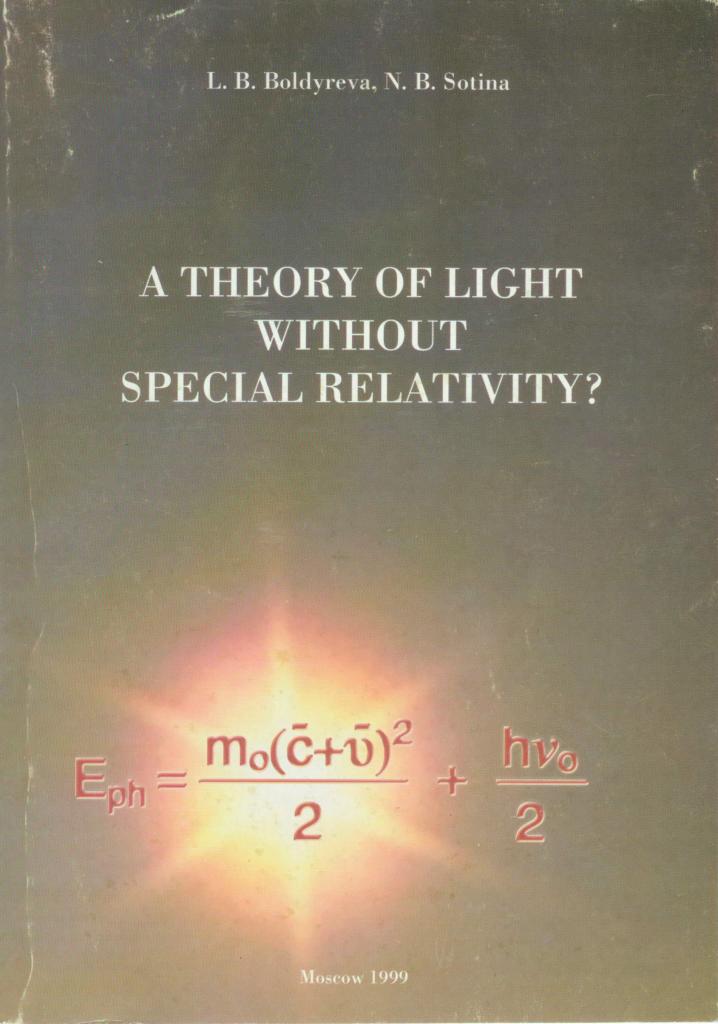
View count: 1
Pages: 62
Publisher: Logos (Moscow)
Year: 1999
ISBN: 593124152
The nature of light being a subject of intensive research and speculation over the centuries still remains a "dark" issue of modern physics. It been established that light transfers energy from the source to the receiver by discrete portions, the quanta. However, there is no unified point of view on the nature of the material carrier of the light quantum, that is, the photon. There are several types of photon used in descriptions of the experiments that demonstrate quantum optical effects (Sec. 5). The difference in usage of the term "photon" reflects the difference in interpretation of the results of such experiments.
Among quantum optical effects the so-called "essentially quantum effects" that have no classical analogues are worth special mentioning. Such effects cannot be described in the framework of the semi-classical model based on the Maxwell equations, and quantum models are used to describe the effects.
Although the quantum formalism provides a good description of the essentially quantum optical effects, there are great difficulties in its interpretation. In this work it will be shown (Sec. 1) that any of the well-known interpretations of the quantum formalism for the case of "nonclassical" light is inconsistent with the main concepts of the special theory of relativity. The main disagreement between special relativity and quantum theory is in the attitude towards measurement. While measurement is of primary importance in quantum mechanics, relativity asserts that all the detected characteristics of light exist a priori (before the measurement). All implications of special are postulated for any inertial frame of reference, not for physical frames (in the sense of actually existing laboratories) as it must be in the study of a quantum object (Sec. 2)...
Pages: 280
Publisher: George Allen and Unwin
Year: 1961
ISBN: B000FSRQQI
ISBN: B0006DB2YE
ISBN: B000ZN9TC2
Websites: en.wikipedia.org/wiki/Herbert_Dingle
This book originated in the belief that there is an urgent need at the present time for a greater association between philosophers and scientists and of both with religious people. The problem of bringing this association into being is approached from different angles by the two authors, who, while agreeing on the main thesis, differ on many details, and the discussion is largely concerned with an examination of the points of difference. It ranges over the significance of scientific concepts, such as ether, energy, space and time, the place of mathematics in science and of linguistics in philosophy, the nature of scientific thought in relation to the universe as a whole, problems of life, mind, ethics and theology. It also raises questions of importance concerning the present attitudes of organizations dealing with these matters towards their respective concerns.
In the course of the discussion, Dingle described how a scientific paper critical of special relativity was rejected by various journals. Part of the paper is reproduced as Appendix II of the book, and is a very clear description of his "Proof that Einstein?s Special Theory cannot correspond with fact."
Publisher: Cambridge University Press
Year: 1989
ISBN: 052132467X
ISBN: 978-0521324670
This richly detailed biography captures both the personal life and the scientific career of Isaac Newton, presenting a fully rounded picture of Newton the man, the scientist, the philosopher, the theologian, and the public figure. Professor Westall treats all aspects of Newton's career, but his account centers on a full description of Newton's achievements in science. Thus the core of the work describes the development of the calculus, the experimentation that altered the direction of the science of optics, and especially the investigations in celestial dynamics that led to the law of universal gravitation.
Review
'This monumental scientific biography provides a masterly, well-documented summary of contemporary views of all the many facets of Newton's astounding wide-ranging career.' Nature
'The first detailed biography of Newton written by a professional historian of science who, over the years, has mastered the prodigious literature, weighted it judiciously, and still manages to reveal new insights by delving into the mass of Newton's unpublished writings. Westall has produced a work of major significance.' Science
'A monumental biography, and a delight to read.' The New Yorker
'Richard Westall has done Newton proud.' The Economist
Pages: 480
Publisher: Oxford University Press
Year: 2009
ISBN: 0195132033
ISBN: 978-0195132038
Pages: 792
Publisher: World Scientific Publishing Company
Year: 2003
ISBN: 9812383670
ISBN: 978-9812383679
Websites: www.worldscibooks.com/physics/5272.html
This book is aimed at a large audience: scientists, engineers, professors and students wise enough to keep a critical stance whenever confronted with the chilling dogmas of contemporary physics. Readers will find a tantalizing amount of material calculated to nurture their thoughts and arouse their suspicion, to some degree at least, on the so-called validity of today's most celebrated physical theories.
Contents:
- Wave Meaning of the Special Relativity Theory
- Change of Reference Frame
- Relativistic and Classical Mechanics
- Experimental Tests of Special Relativity
- Partial Differential Equations of Second Order
- The Wave Packet Concept
- Electromagnetism
- Electromagnetic Induction
- Amp?re and Lorentz Forces
- The Li?nard?Wiechert Potential
- Analysis of the Electromagnetic Field
- Photonics Versus Electromagnetism
- Radiation of Extended Sources
- The Green Formulation
- Wave Extinction in a Dielectric
- Plasma Equation
Readership: Students and academics in advanced physics.
From the Publisher
International contributors present a comprehensive cross section of the state of the art as it stands today. These volumes feature review articles by the Poznan School and associated laboratories, as well as a selection of reviews contributed from many of the leading laboratories around the world in the various fields of nonlinear optics. Contains a wealth of illustrations.
Pages: 474
Publisher: Hadronic Press
Year: 1995
ISBN: 091176772X
ISBN: 978-0911767728
Proceedings of an International Conference held 1994 in Olympia, Greece
Contents:
FUNDAMENTAL IDEAS:
- Michele Barone, The Underwater Neutrino Telescopes 1
- Jenner Barretto Bastos-Filho & R. M. X. de Araujo, Dimensional Analysis and Fundamental Physical Constants in N-Dimensional Spaces for Real N 11
- G. F. Sanger, On Mechanisms of Ambiguity and Adaptation in Nature and Their Dimensions 23
- Ruggero Maria Santilli, An Introduction to Hadronic Mechanics 69
RELATIVITY
- Roland H. Dishington, Cause and Effect in Special Relativity 187
- Joseph Levy, Is the Invariance of the Speed of Light Compatible with Quantum Mechanics? Some New Arguments 203
- Constantin I. Mocanu, Hertzian Extension of Einstein Special Relativity to Non-Uniform Motions 217
- A. Panaitescu, On the Electromagnetic State Quantities in Electrodynamics of Moving Media 241
- A. Paparodopoulos, The Law of Universla Gravitation in a G Variant Universe 265
- Simon J. Prokhovnik, The Nature of Friedmann Universes 277
- Horst E. Wilhelm, Physical Foundations of Galilei Covariant Electrodynamics 283
QUANTUM PHYSICS
- A. Afriat, Correlations Involving Several Subsystems 2999
- Co. Antonopoulos, On Measurements with Contradictory Results; Tracing the Roots of the Original Wholeness 313
- A. K. Aringazin, K. M. Aringazin, A. Baskoutas, G. Brodimas, A. Jannusis & E. Vlachos, q-Deformed Harmonic Oscillator in Phase Space 329
- M. Damjanonvic & Z. Maric, Relativistic Dynamics and Space-Time Structure of Few-Body Processes 349
- J. Foadi, A Geometrical Approach to Bell Inequalities 357
- L. C. B. Ryff, Some Reflections and Conjectures on E.P.R. Correlations and Realism 369
- Franco Selleri, Complementarity vs. Causality in Space and Time 381
- James Paul Wesley, Light Radiates as Stochastic Bursts of Photons 399
GEOPHYSICS
- V. P. Ivankin, On the Origin and Development of the Solar System 409
- Martin Kokus, Red-Shift Quantization and the Fractal Geometry of the Universe 425
- H. G. Owen, Speculations on the Physical State of the Earth's Inner Core 429
- Giovanni Scalera, Relocation of Paleopoles on Variable Radius Earth Models 463
Pages: 192
Publisher: Ultreja (Padova)
Year: 1998
Websites: www.cartesio-episteme.net www.dipmat.unipg.it
The book by Umberto Bartocci, Albert Einstein and Olinto De Pretto: The True Story of the Most Famous Formula in the World (Bologna, Andromeda, 1999) is likely to become even more rare than De Pretto if the publisher does not hasten to reprint. The book is part of the series History impossible, is a book just in time, that is printed just in time, in time to be saved. It is 'the fate of those books that publishers do not consider suitable for publication and that without such a formula would not be able to ever see the light. The manuscripts would fall into oblivion, with the passage of time should be lost in a move or because of some relative distracted. Are the chills to think about how many novels, essays or those who scientific work has been denied even the simple come to light. Certainly the story was written by unknown hands, which sometimes was not the slightest trace. And it is very exciting to follow these mysterious footsteps. In the near future - and can play almost as a joke - the book Bartocci may be disputed by bibliophiles in search of original texts and prophetic, that do not have marked an era when their silent exit, but they did afterwards, as anticipatory of truth have become such only in the future, sometimes a distance of many years. It is a simple paperback publishing in the eighth, with the black cover on all sides. The face of Einstein and the atomic mushroom that campeggio sul front are two very clear symbols of the concept expressed by the most famous formula in the world. Before that book Bartocci had tried - in vain - to accept for publishing a four-hands, with Marco Mamone Capria on the same topic. The scientific journal to which he had directed the rejected manuscript, in a courteous but final. All these difficulties stem from the responsibility that is behind the name of Albert Einstein. Still too great and splendid is its star to be able to blur without exposing brutally critical of the 'scientific orthodoxy. Einstein can not be questioned, not yet, at least. Perhaps one day new conceptions of the world of physics toned down his theories, but at the moment remains an immovable pillar, slightly less than untouchable. For this reason that no magazine wants to be a voice worthy of note in academic would dare hold a decidedly "against the tide" that is not supported by evidence and irrefutable around a doubt - albeit qualified - on the paternity of the most famous formula world. It is logical that the problem at the moment can not be presented to a level of conjecture. It is not yet certified, if it ever will be, that Albert Einstein read the work of Olinto De Pretto and, above all, it drew inspiration. Perhaps the only feasible way is to focus attention on the figure of Michele Besso, who was a friend Einstein and connected to De Pretto. Einstein knew Italian, also held conferences in our language. The science seems not to want to make that De Pretto, this obscure agronomist Vicenza, perhaps inspired the great scientist. Maybe they are formal, not decisive, since the concept of ether does not seem to be applied to the theory of relativity, but certainly the phrase that appears in the work of De Pretto 1904 (a year before Einstein published in Annalen der Physik his two famous works) is explanatory in this regard: "The matter of whatever a body contains in itself a sum of energy represented the entire mass of the body, which moved all united and collectively in space, with the same velocity of individual particles. [...] the mv formula gives us the strength and the living formula mv2 gives us, expressed in calories, such energy. Since m = lev equal to 300 million meters, which would be the speed of light, also admitted to the ether, everyone will see that you get a lot of calories represented by 10,794 followed by 9 zeroes that is, more than ten million million."
Pages: 408
Publisher: Xtx
Year: 2002
ISBN: 0971962987
ISBN: 978-0971962989
"The appearance of Dr. Silberstein's recent article on 'General Relativity without the Equivalence Hypothesis' encourages me to restate my own views on the subject. I am perhaps entitled to do this as my work on the subject of General Relativity was published before that of Einstein and Kottler, and appears to have been overlooked by recent writers." -- Harry Bateman
"All this was maintained by Poincare and others long before the time of Einstein, and one does injustice to truth in ascribing the discovery to him." -- Charles Nordmann
"[Einstein's] paper 'Zur Elektrodynamik bewegter Koerper' in Annalen der Physik. . . contains not a single reference to previous literature. It gives you the impression of quite a new venture. But that is, of course, as I have tried to explain, not true." -- Max Born
"In point of fact, therefore, Poincare was not only the first to enunciate the principle, but he also discovered in Lorentz's work the necessary mathematical formulation of the principle. All this happened before Einstein's paper appeared." -- G. H. Keswani
"Einstein's explanation is a dimensional disguise for Lorentz's. . . . Thus Einstein's theory is not a denial of, nor an alternative for, that of Lorentz. It is only a duplicate and disguise for it. . . . Einstein continually maintains that the theory of Lorentz is right, only he disagrees with his 'interpretation.' Is it not clear, therefore, that in this, as in other cases, Einstein's theory is merely a disguise for Lorentz's, the apparent disagreement about 'interpretation' being a matter of words only?" -- James Mackaye
"The secret to creativity is knowing how to hide your sources." -- Albert Einstein

